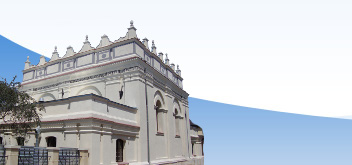 |
 |
 |
 |
| home | news | about us | the heritage | projects | partners | gallery | contact |
 RABBINICAL COMMISSION FOR CEMETERIES 
Rabbinical Commission for Cemeteries. Guidelines for the preservation of Jewish cemeteries in Poland Status of the cemeteries in Jewish law and tradition A Jewish burial is mentioned for the first time in the Book of Genesis, when after the death of his wife Sara, Abraham bought a piece of land to bury her in it. (Genesis 23:2-20) In the Jewish tradition, the cemetery is created at the moment of purchase of a lot of land for the burial purposes – the land obtains its special status even before the first burial. In Judaism both – the spirituals and physical – are holy. The soul is the source of the holiness, while the body is a vessel that carries it. According to the Jewish tradition and law, human body is holy even after death and remains so till the Judgment Day. Therefore the bones of the departed remain holy and inviolable. Tradition says that the soul and body are connected even after death; therefore if the bones are violated here on Earth, the peace of the soul in Heaven is also violated. Because the bones are sacred they need to be treated with the utmost respect. The bodies of the departed must be buried in the ground (this excludes both cremation and leaving them above ground) and remain untouched. This is the reason why in Judaism the exhumation is strictly forbidden, except special and extraordinary cases. Commission Activities in Poland The Commission was established to supervise all the works taking place at the Jewish cemeteries in Poland. The focus of the Commission is the preservation of the cemeteries in their historical borders (pre-war borders). From the point of view of the Jewish law, within which the Commission operates, the key issue is the preservation of the human remains buried at the cemetery, regardless whether said remains are placed in the anatomical order or are mixed with the soil. In other words, according to the Jewish tradition the cemetery is where the human remains are, regardless whether the external signs of the cemetery were destroyed, its boundaries were blurred or the cemetery was built-up. In this regard the Commission's task is to prevent the building up of the cemeteries, as well as expanding the facilities already existing that were constructed during the World War II, Polish People’s Republic or after 1989. The fact that the necropolis was built-up and human remains desecrated in the result of past earthworks does not mean that Jews no longer consider this area a cemetery – a holy place. Methodology of the Commission's work: performing works at the cemeteries Judaism expressly prohibits interference in the earth structures at the Jewish cemeteries due to the danger of moving the bones. Therefore, allowed by the Jewish tradition are only noninvasive research methods. In order to recreate the historical borders of the cemetery or recognize the burial zone, the following tools are available: synchronization of the pre-war maps, synchronization of the aerial photos from the World War II, GPR surveys and LIDAR (light detection and ranging). The basic tool is an on-site verification – checking the area for the remains of the pre-war fence or other cemetery objects. The archeological excavations are allowed only in special cases, under consultation with the Commission and under the rabbinical supervision of the delegated Commission employee. Tombstones According to the Jewish tradition matzevot belong to the deceased and therefore should be returned to the cemetery of origin. It is not allowed to re-set the so-borne matzevot in a way imitating the original setting, suggesting that they are located in the original spot – original burial place. The Commission recommends that in such case, the optimal solution is a creation of the lapidary, integrated with an existing fence or located in its vicinity. The exact location of the lapidary should be agreed with the Rabbinical Commission. Moreover digging, raising or re-setting tombstones that fell, were overgrown or covered by the soil at the cemetery is forbidden. Summarizing, forbidden are all activities that may violate the human bones located under the surface of the earth. Any renovation, maintenance and care for the matzevot should be performed in accordance to the conservation procedures and in case of any doubt – consulted with the Commission. Practical remarks:
Guidelines for conducting work on Jewish cemeteries The following guidelines apply both to the fenced and marked cemeteries, as well as to those which borders are not recreated yet. In case of the latter ones it should also be noted that one of the forms of the protection of their burial zone is to change the land use to the “green area”, subject to the public notification that the given area is a cemetery; it should be noted in a way that will leave no doubt that the area should not be used for recreational purposes. From the point of view of the Jewish tradition, the most important is providing peace of the dead and the inviolability of their burials. Therefore all works conducted at the cemeteries, including projects aiming to recreate their historical borders, should take into account these priorities Within the Jewish cemeteries – it is not allowed:
it is allowed:
Notice: If you find human remains stop working immediately and contact the office of the Commission. In case of any substantive questions or concerns, please contact the Rabbinical Commission directly (6 Twarda St., 00-950 Warsaw, tel. +48 22 526 54 59, E-mail: komisja.rabiniczna@jewish.org.pl). » back |

|
||||||||||||||||||||
 |
||